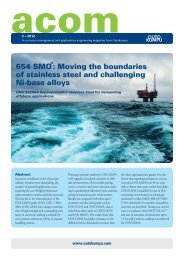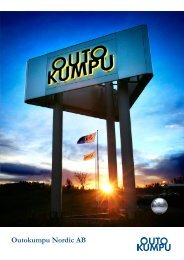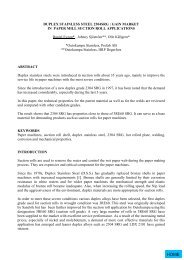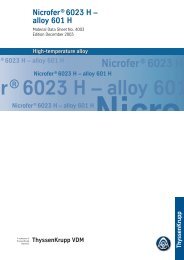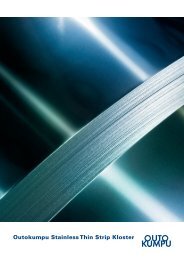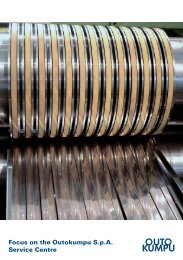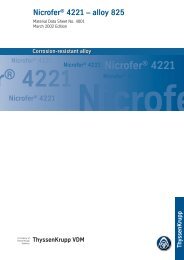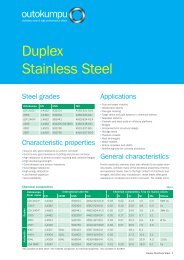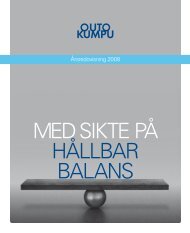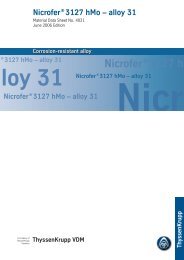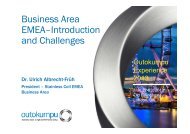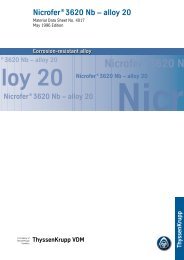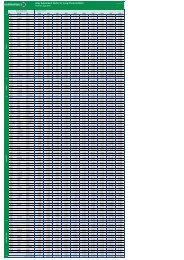Annual Report 2010 - Outokumpu
Annual Report 2010 - Outokumpu
Annual Report 2010 - Outokumpu
You also want an ePaper? Increase the reach of your titles
YUMPU automatically turns print PDFs into web optimized ePapers that Google loves.
72<br />
Energy efficiency<br />
<strong>Outokumpu</strong> sites use a range of fuels including direct energy sources such as natural gas, propane, heavy fuel oil and<br />
electricity. Direct energy use by the Group totalled 7.0 million GJ in <strong>2010</strong> and electricity consumption totalled 10.0 million<br />
GJ (2.8 million megawatt hours). Total energy consumption, 17.0 million GJ, increased some 31% compared to previous<br />
year mainly due to recovering process volumes and the long production stoppage of Ferrochromium smelter during<br />
2009. Total annual energy consumption by <strong>Outokumpu</strong> is approximately equivalent to the amount of energy consumed<br />
by 210 000 Scandinavian households. Electricity consumption compares to about 30% of the annual output of a modern<br />
1 600 MW nuclear power plant.<br />
<strong>Outokumpu</strong>'s Energy & low-carbon programme<br />
In the last ten years, <strong>Outokumpu</strong> has reduced the Group's direct carbon dioxide (CO 2 ) emissions by 25% per tonne of<br />
stainless steel produced. In the <strong>Outokumpu</strong> Energy and low-carbon programme, published at the beginning of <strong>2010</strong>,<br />
<strong>Outokumpu</strong>'s target is a 20% reduction in the Group's specific carbon emissions profile in stainless steel production by<br />
2020. In assessing and measuring the Group's carbon profile, we utilise a method of calculation which focuses on factors<br />
that <strong>Outokumpu</strong> can manage and control.<br />
The targets set in <strong>Outokumpu</strong>'s Energy and low-carbon programme highlight not only specific reductions but also the<br />
Group's production efficiency, as emissions are calculated per tonne of stainless steel produced. These targets connect<br />
our materials and energy efficiency and supply chain management to our business targets. The figure for monitoring<br />
progress is the 3-year moving average that is compared to the baseline, which is the 2007–2009 period. Targets of the<br />
Energy and low-carbon programme represent optimal Group-wide environmental objectives both for <strong>Outokumpu</strong> and for<br />
combating climate change. They also support the Group's strategic goals and their achievement is supported by different<br />
energy and quality programmes. As the targets are both quantitative and a clear demonstration of our long-term<br />
commitment in this area, they encourage continuous improvement.<br />
Calculated in terms of current capacity and production, the annual reduction in CO 2 emissions being targeted is<br />
approximately 370 000 tonnes by 2020, which means a total reduction of 2 200 000 tonnes over the <strong>2010</strong>–2020<br />
programme period.<br />
Our actions and the results achieved<br />
<strong>Outokumpu</strong> <strong>Annual</strong> <strong>Report</strong> <strong>2010</strong> – Business – Energy efficiency




